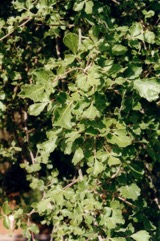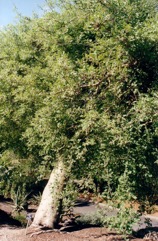African myrrh

A tropical plant. It favours low dry woodland. It grows on sandy flats or rocky ridges. In East Africa it grows between 50 and 1,800 m altitude. In Kenya it grows in regions with a rainfall between 400-1,000 m altitude. It can grow in arid places. It grows in the Sahel. It grows in Miombo woodland. In Brisbane Botanical Gardens.
Also known as:
Agarat, Anqua, Dashi, Dedeck, Ekadeli, Ekadili, Etopojo, Gafal, Hairy corkwood, Horgoog, Iminyela, Inchone, Itula, Kabi, Khobo, Khozyo, Kidirigheta, Kitungu, Liminyela, Mbambara, Mogorokoko, Morophaphiri, Msilale, Mtono, Mturituri, Mubvuka, Muchabobo, Mugugudo, Mugugudu, Mukwendekwende, Munyera, Mutungu, Naamo, Orido, Osilalei, Poison-grub commiphora, Qahitta, Siponda, Tchindjove, Togoria, Za, Zanzachenana
Synonyms
- Commiphora pilosa (Engl.) Engl.
- Commiphora benadirensis Mattei
- Commiphora calcicola Engl.
- Balsamodendron africanum (A. Rich.) Arn.
- Heudelotia africana A. Rich.
Edible Portion
- Fruit, Roots, Leaves, Bark, Gum
Where does African myrrh grow?
Found in: Africa, Angola, Benin, Botswana, Burkina Faso, Cameroon, Central Africa, Chad, Congo, Côte d'Ivoire, East Africa, Eswatini, Ethiopia, Gambia, Ghana, Ivory Coast, Kenya, Malawi, Mali, Mauritania, Mozambique, Namibia, Niger, Nigeria, Rwanda, Sahel, Senegal, Somalia, South Africa, Southern Africa, South Sudan, Sudan, Swaziland, Tanzania, Togo, Uganda, West Africa, Zambia, Zimbabwe
Notes: There are about 165-190 Commiphora species. They are common in Africa.
Status: The roots are especially eaten by children.
Growing African myrrh
Cultivation: It can be grown from seeds or cuttings. It can be grown from stakes. It can be planted as a live hedge.
Edible Uses: The centre of the roots is eaten when food is scarce. It is eaten raw. It is sweet. Bark is used to make a tea. The young fruit is eaten raw. Caution: The leaves are eaten but may contain poisons. They are cooked with potash and groundnuts.
Production: It flowers and fruit throughout much of the year in Ethiopia. The rootstock is collected during the rainy season.
Nutrition Info
per 100g edible portion| Edible Part | Energy (kcal) | Protein (g) | Iron (mg) | Vitamin A (ug) | Vitamin c (mg) | Zinc (mg) | % Water |
|---|---|---|---|---|---|---|---|
| - | - | - | - | - | - |
African myrrh Photos


References
Asfaw, Z. and Tadesse, M., 2001, Prospects for Sustainable Use and Development of Wild Food Plants in Ethiopia. Economic Botany, Vol. 55, No. 1, pp. 47-62
Ballal, M. E., et al, 2014, Ethno-botany of Natural Forests of Nuba Mountains, South Kordofan State, Sudan. Journal of Forest Poducts & Industries. 3(1):13-19
Bekele-Tesemma A., Birnie, A., & Tengnas, B., 1993, Useful Trees and Shrubs for Ethiopia. Regional Soil Conservation Unit. Technical Handbook No 5. p 164
Burkill, H. M., 1985, The useful plants of west tropical Africa, Vol. 1. Kew.
A. L. P. P. de Candolle & A. C. de Candolle, Monogr. phan. 4:14. 1883
Dalziel, J. M., 1937, The Useful plants of west tropical Africa. Crown Agents for the Colonies London.
Dansi, A., et al, 2008, Traditional leafy vegetables and their use in the Benin Republic. Genet Resour Crop Evol (2008) 55:1239–1256
Dansi, A., et al, 2009, Traditional leafy vegetables in Benin: folk nomenclature, species under threat and domestication. Acta Bot. Gallica 156(2), 183-199
Dharani, N., 2002, Field Guide to common Trees & Shrubs of East Africa. Struik. p 215
Exell, A.W. et al, (Ed), 1963, Flora Zambesiaca Vol 2 Part 1 Crown Agents, London. p 276
Feyssa, D. H., et al, 2011, Seasonal availability an consumption of wild edible plants in semiarid Ethiopia; Implications to food security and climate change adaptation. Journal of Horticulture and Forestry 3(5): 138-149
Fowler, D. G., 2007, Zambian Plants: Their Vernacular Names and Uses. Kew. p 15
Fox, F. W. & Young, M. E. N., 1982, Food from the Veld. Delta Books. p 140
Gallagher, D. E., 2010, Farming beyond the escarpment: Society, Environment, and Mobility in Precolonial Southeastern Burkina Faso. PhD University of Michigan.
Glover, et al, 1966b,
Goode, P., 1989, Edible Plants of Uganda. FAO p 30 (As Commiphora pilosa)
Grivetti, L. E., 1980, Agricultural development: present and potential role of edible wild plants. Part 2: Sub-Saharan Africa, Report to the Department of State Agency for International Development. p 41, 44
Hahn, K., et al, 2018, The Use of Wild Plants for Food: a National Scale Analysis for Burkina Faso (West Africa) Flora et Vegetatio Sudano-Sambesica 21, 25-33
Hanawa, Y., 2013, Wild edible plants used by Guiziga people of far north region of Cameroon. Int. J. Med. Arom. Plants. Vol 3 (2) : 136-143
Harris, F. M. A. and Mohammed, S., 2003, Relying on Nature: Wild Foods in Northern Nigeria. Ambio Vol. 32 No. 1. p 25-30
http://aflora.africa.kyoto-u.ac.jp
Jardin, C., 1970, List of Foods Used In Africa, FAO Nutrition Information Document Series No 2.p 69, 130
Johns, T., Mhoro, E. B. and Sanaya, P., 1996, Food Plants and Masticants of the Batemi of Ngorongoro District, Tanzania. Economic Botany, Vol. 50, No. 1, pp. 115-121
Johns, T., Mhoro, E. B. and Sanaya, P., 1996, Food Plants and Masticants of the Batemi of Ngorongoro District, Tanzania. Economic Botany, Vol. 50, No. 1, pp. 115-121 (Also as Commiphora abyssinica)
Katende, A.B., Birnie, A & Tengnas B., 1995, Useful Trees and Shrubs for Uganda. Identification, Propagation and Management for Agricultural and Pastoral Communities. Technical handbook No 10. Regional Soil Conservation Unit, Nairobi, Kenya. p 200
Larson, T. J., 1970, Hambukushu Ethno-botany. Botswana Notes and Records. Vol 13.
Le Houerou, H. N., (Ed.), 1980, Browse in Africa. The current state of knowledge. International Livestock Centre for Africa, Ethiopia. p 161
Long, C., 2005, Swaziland's Flora - siSwati names and Uses http://www.sntc.org.sz/flora/
Lulekal, E., et al, 2011, Wild edible plants in Ethiopia: a review on their potential to combat food insecurity. Afrika Focus - Vol. 24, No 2. pp 71-121
Malaisse, F., 1997, Se nourrir en floret claire africaine. Approche ecologique et nutritionnelle. CTA., p 91.
Mannheimer, C. A. & Curtis. B.A. (eds), 2009, Le Roux and Muller's Field Guide to the Trees and Shrubs of Namibia. Windhoek: Macmillan Education Namibia. p 200
Maundu, P. et al, 1999, Traditional Food Plants of Kenya. National Museum of Kenya. 288p
Maydell, H. von, 1990, Trees and shrubs of the Sahel: their characteristics and uses. Margraf. p 243
Mbuya, L.P., Msanga, H.P., Ruffo, C.K., Birnie, A & Tengnas, B., 1994, Useful Trees and Shrubs for Tanzania. Regional Soil Conservation Unit. Technical Handbook No 6. p 194
MORTIMORE,
Mutie, F. G., 2020, Conservation of Wild Food Plants and Their Potential for Combatting Food Insecurity in Kenya as Exemplified by the Drylands of Kitui County. Plants 2020, 9, 1017
Njana, M. A., et al, 2013, Are miombo woodlands vital to livelihoods of rural households? Evidence from Urumwa and surrounding communities, Tabora, Tanzania. Forests, Trees and Livelihoods, 22:2, 124-140
Palgrave, K.C., 1996, Trees of Southern Africa. Struik Publishers. p 357
Palmer, E and Pitman, N., 1972, Trees of Southern Africa. Vol. 2. A.A. Balkema, Cape Town p 1031
Peters, C. R., O'Brien, E. M., and Drummond, R.B., 1992, Edible Wild plants of Sub-saharan Africa. Kew. p 72
Plowes, N. J. & Taylor, F. W., 1997, The Processing of Indigenous Fruits and other Wildfoods of Southern Africa. in Smartt, L. & Haq. (Eds) Domestication, Production and Utilization of New Crops. ICUC p 189
Roodt, V., 1998, Trees & Shrubs of the Okavango Delta. Medicinal Uses and Nutritional value. The Shell Field Guide Series: Part 1. Shell Botswana. p 193
Royal Botanic Gardens, Kew (1999). Survey of Economic Plants for Arid and Semi-Arid Lands (SEPASAL) database. Published on the Internet; http://www.rbgkew.org.uk/ceb/sepasal/internet [Accessed 4th April 2011]
Ruffo, C. K., Birnie, A. & Tengnas, B., 2002, Edible Wild Plants of Tanzania. RELMA p 222
Ruiters-Welcome, A. K., 2019, Food plants of southern Africa. Ph.D. thesis. Univ. of Johannesburg p 40
Schmidt, E., Lotter, M., & McCleland, W., 2007, Trees and shrubs of Mpumalanga and Kruger National Park. Jacana Media p 244
Some Kasigau Woody Plants and their Uses. 2013, National Geographic and Miami University
Swaziland's Flora Database http://www.sntc.org.sz/flora
van Wyk, Be., & Gericke, N., 2007, People's plants. A Guide to Useful Plants of Southern Africa. Briza. p 84
White, F., Dowsett-Lemaire, F. and Chapman, J. D., 2001, Evergreen Forest Flora of Malawi. Kew. p 176
Williamson, J., 2005, Useful Plants of Malawi. 3rd. Edition. Mdadzi Book Trust. p 77
World Checklist of Useful Plant Species 2020. Royal Botanic Gardens, Kew
www.worldagroforestrycentre.org/treedb/
www.zimbabweflora.co.zw 2011